The search for non-toxic spray paint was not a straightforward one, it took a lot of searching through brands, looking at ingredient lists, and even testing some myself.
I started by looking at water-based aerosol paints since they are lower odor and have fewer fumes than solvent-based paints.
However, even water-based spray paints are not technically low-VOC, since the propellant is a solvent. Still, they can be fast to offgas and are certainly less toxic than solvent-based paint.
Next up, I found a lot of hybrids – water and ethanol-based paints. While those paints do aerosolize alcohol, this alcohol is very fast to evaporate and so this is still a great paint for those looking for safer options.
Then, finally, I tested the solvent paint options from major brands to see which ones become odorless when dry (and how many days exactly does it take to finish offgassing and become non-toxic).
The last section covers no-VOC paints that are not aerosols but can be spray-applied. If you want a paint without VOCs, without any solvents including propellants, but you still need to cover difficult-to-paint surfaces, these are the options to look at.
Many of these paints can be used on furniture, decor, and crafts that are for sensitive folks, for kids, and for animal enclosures.
This article contains affiliate links, upon purchase I make a small commission at not extra cost to you.
Spray Paint Types
Resin Type
Spray paint resins include acrylic (also called latex), polyurethane, alkyd (enamel), and nitrocellulose. In my experience acrylic resin water-based paint has been the lowest in odor, though I don’t discount the other options, especially if you need something durable.
Solvent Type
Spray paint comes in two bases: solvent-based and water-based.
There is also a hybrid of water and ethanol. Ethanol is overall a much safer solvent than those used in heavy petroleum solvent-based paints. You do have to be careful with inhaling it when wet, but it evaporates very fast. I’ve included the ethanol-water hybrid in the water-based section because it’s so safe.
Water-based spray paints are slower to dry, and less durable, but less toxic. They are lower odor and are safe to use inside. Many are safe for kids to use for small projects.
You will want to check if your project requires a primer or even a top coat over your water-based spray paint to be durable.
Solvent-based spray paints are more durable, and can usually stick to a wider variety of surfaces, they dry very fast but are certainly much more toxic when wet and take days or weeks to fully cure and stop offgassing.
Solvents can include heavy aromatic solvents, which are quite harsh at first. Other solvents like acetone are preferred, partially because of how fast that one flashes off. On the other hand, acetone is an exempt VOC, it won’t be counted on the total VOC content.
I do list the VOC content when the company provides it, but it’s hardly useful in determining the safest aerosol spray paint, why:
- Ethanol has a high VOC count even though it evaporates extremely fast (perhaps 20 minutes at most).
- Acetone is not counted as a VOC, but also offgasses quickly.
- The propellant can add to the VOC level even though it comes out in gas form, not liquid, so is also fairly fast to disperse.
- Almost all spray paints are in the 400-600 g/l range.
Environmental and Health Concerns with the Gas/Propellant Added to Cans.
Aerosol spray paint cans are filled first with paint and then a compressed or liquified gas as the propellant. When the paint comes through the nozzle, the propellant expands into gas form.
Up until the 1980s, many aerosol cans used chlorofluorocarbons (CFCs) as a propellant. But once it was concluded that these were harmful to the ozone layer, these were discontinued. Almost all aerosol cans contain alternative propellants that are not a risk to the ozone layer.
Common Propellants:
Dimethyl ether (DME) is the most common propellant that I saw listed in spray paints. DME is a biofuel, it can be used as the sole propellant or it can be found mixed with hydrocarbon propellants. DME is compatible with water, so it was found in almost all of the water-based spray paints that I looked at. It is considered relatively non-toxic (though there are hazards to short-term exposure), it has a faint ether-like odor, and it does not harm the ozone layer.
Hydrocarbon propellants include propane, butane, propane-butane, and pentane.
Compressed gasses are used in about 10% of today’s aerosols says one source. Gases like carbon dioxide, nitrous oxide, and nitrogen can be used as propellants. I only saw one paint that used one of these more benign gases.
Why Does Spray Paint Contain a Prop 65 Warning?
The California Prop 65 warning is found on almost all spray paint cans. Prop 65 warns against compounds that can cause cancer or reproductive harm. In some cases, this is only a warning on the pigments like titanium dioxide and carbon black. Those two are only harmful when breathed in, not when in the final solid form. So be sure to wear the appropriate PPE but otherwise, there is no need to be alarmed by this warning.
Two other compounds sometimes found in spray paint that are Prop 65 chemicals are benzene and toluene. Though most of the paints here use these solvents either in very small amounts or they use safer solvents. To mitigate against the effects of solvents, again, use the appropriate PPE, apply the spray paint outside, and bring the item in only after it has offgassed.
What Should You Look for in a Non-Toxic Spray Paint:
- Water-based formula.
- Water and ethanol formula is also great, just be sure not to inhale it.
- Very few spray paints have an inert gas propellant, DME and propane are common and therefore rather unavoidable. I only saw one paint with nitrogen or carbon dioxide as the propellant.
- Consider the use of a zero-VOC spray applied (non-aerosol) paint in the last section (no propellants and no VOCs).
- If going with a solvent-based paint, look for options that are heavy in acetone and light in aromatic petroleum solvents.
- If you go with one of the solvent-based spray paints I tested, I would recommend applying it outside and waiting for the full cure time that I mention in the post before bringing it inside for use by sensitive folks, babies, kids, or pets.
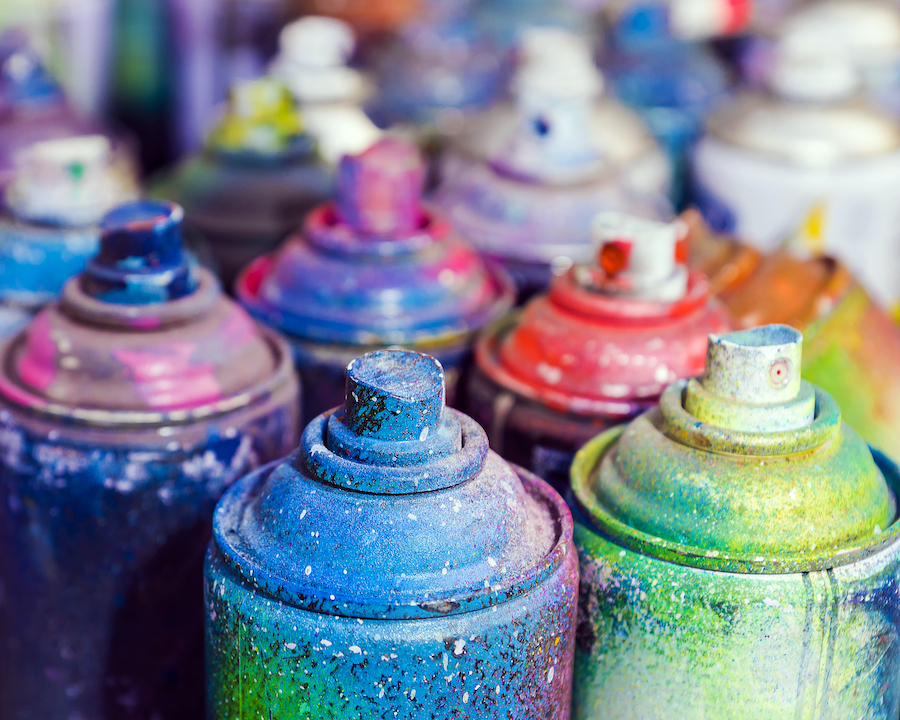
Non-Toxic Water-Based Spray Paints
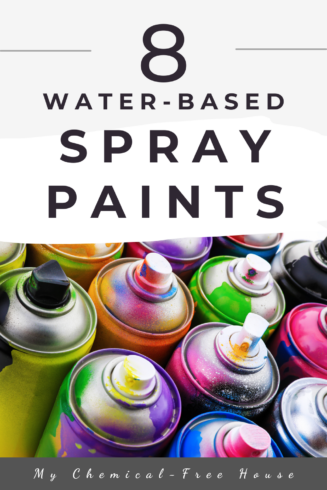
Water-based spray paints are lower odor, low-fume, and safe to use indoors. They are slower drying than solvent-based spray paints.
Some of them are durable enough for both indoor and outdoor projects, though some might need a protective coat. Many have good coverage on a wide variety of substrates, a few might require a primer.
You do tend to see reviews talking about the cans being finicky, be sure to carefully follow the instructions for use, as it differs slightly from solvent-based paints.
If you are sensitive to chemicals or you are painting something for a baby, child, or animal, a water-based formula is the best option.
You still need to wear proper PPE when spraying them, be sure to follow their directions.
1. Pintyplus Water-Based Spray Paints
Aqua Spray Paint (For Crafting)
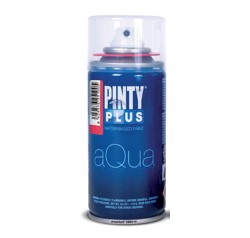
This is a water-based, low-VOC, low odor, acrylic spray paint. It’s perfect for indoor arts and crafts, especially for kids.
While some people find Pinty Plus Aqua odorless, lots of people have described the odor as minimal. It’s safe to use this spray paint indoors. It has an ultra-matte look.
DME looks to be the main propellant (45-55%), followed by Propan-2-ol (10-25%), it also lists xylene at less than 2%. VOCs at 620 g/l on the matte.
Uses: Decorating small objects in the home, arts and crafts, stenciling, and scrapbooking.
Substrates: Paper, cardboard, wood, rope, natural fibers, cork, canvas, stone, cement, plaster, metal (including carbon steel and stainless steel), methacrylate, polystyrene, and balloons.
Over plastic and glass then recommend using their primer Pintyplus Tech.
Where to use: Interior and exterior.
Clean up: Soap and water.
Colors: 6 pastel colors plus black & white.
Reviews: They have some good reviews but because it’s a water-based spray paint it’s not surprising to find a couple of reviews saying it’s finicky.
Where to buy (US): Amazon, Walmart
- Where to buy in Canada: Amazon.ca
- Where to buy in the UK: Amazon.co.uk or through the Pinty Plus UK store
Prop 65 warning, not clear for which chemical.
Pinty Plus Chalk Finish

If you want a water-based aerosol chalk paint, this is the safest one to go with.
Other big brands of spray chalk paints like those by Rust-Oleum and Krylon are solvent-based, so Pinty Plus Chalk Finish water-based paint is unique.
Uses: Smaller projects like crafts as well as furniture.
Substrates: Wood, melamine, canvas, iron, plastic, cardboard, and even glass. No aggressive solvents mean it’s safe for use on expanded polystyrene.
If you want to paint on plastic they recommend you use Pintyplus Tech plastic primer.
If a layer of varnish is needed, they have a water-based Varnish Pintyplus for over the chalk paint.
Works well for a distressed look.
Where to use: Indoors and outdoors.
Clean up: Soap and water.
Colors: 17 colors – neutrals and pastels.
Prop 65 warning for four chemicals: titanium dioxide, ethylbenzene, and two undisclosed ingredients.
Where to buy (US): Amazon, Walmart, and Lowes
Pinty Plus Evolution
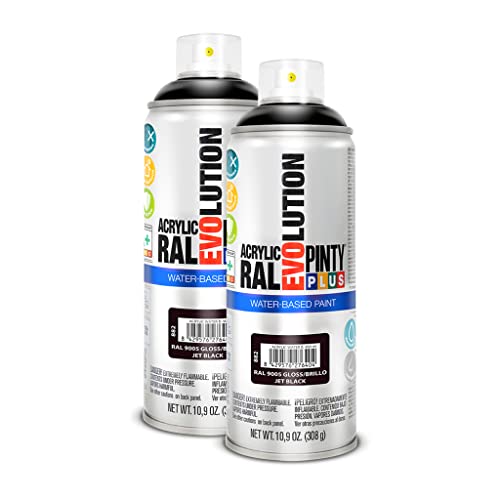
For beyond crafts, this water-based acrylic spray paint is more durable than the brand’s other lines.
Pintyplus Evolution water-based acrylic spray paint is marketed as an environmentally friendly general-purpose spray paint.
It’s very low odor during spraying and once dry it has no odor. It is solvent-free.
It’s an extra-quick drying acrylic spray paint. Total drying is 15 minutes, you can repaint after 5 minutes.
It has a heat resistance of 100 ºC, so it can be used as a radiator paint (more info on that here). It can also be used on toys since it’s certified Toy Safe EN-71(Europe) and ASTM F963 – 17 (US).
To paint on porous surfaces, they recommend Pintyplus Evolution Water Based Primer. On previously painted surfaces, the surface should be sanded to provide adhesion.
Uses: Industrial equipment, pipes, or engineering pieces, to decorative objects such as toys, chairs, benches, garden tables, or even chandeliers.
Substrates: Wood, stone, some plastics, MDF, veneers, glass, clay, ceramics, paper, natural fibers, rubber, cork, textiles, and most metals.
Where to use: Indoors and outdoors.
Clean up: Soap and water.
Colors: 24 bright, muted, and neutral colors.
There is a Prop 65 warning for two compounds that are trade secrets.
Where to Buy (US): Amazon, Walmart, and Home Depot
Pinty Plus HOME

Pinty Plus HOME is designed for indoor-only, larger-sized home decor projects. It has a matte finish.
Formulated with water-based resins, Pinty Plus HOME is very low in odor.
Uses: medium-sized sections of walls, doors, windows, and as well as common pieces of furniture like cabinets, sideboards, cupboards, headboards, tables, or chairs; decorative objects of all types like clay figures, frames, vases or even textiles such as small carpets or decorative pillows.
Not for distressing, see the chalk finish above for a distressed look.
Substrates: Wood in general, MDF, chipboard panels, wood veneers; glass, clay, ceramics, and tiles (with Pintyplus Universal Primer); paper, cardboard, or paper-faced foam board, rubber, cork, and foams in general, Styrofoam, etc.; fibers like bamboo, hemp, etc.; felt; methacrylate and polycarbonate; metals (except aluminum); hard plastics, rigid-transparent-flexible PVC (with Pintyplus Plastic Primer); soft plastic, nets, and bags made of polyethylene, cellular polypropylene and styrofoam (expanded polystyrene).
Textiles such as wool, linen, or cotton, felt, though it is not intended to be used on clothing that will be washed or flexed frequently.
The ideal paint for wood, rope, methacrylate, cork, styrofoam, carbon, and stainless steel.
Where to use: Indoors.
Clean up: Soap and water.
Colors: 21 muted colors plus a metallic brass color.
Prop 65 warning for four chemicals, titanium dioxide, ethylbenzene, and two undisclosed ingredients.
Where to buy (US): Home Depot and Lowes
2. Liquitex Water-Based Spray Paint (Fine Art Paint)
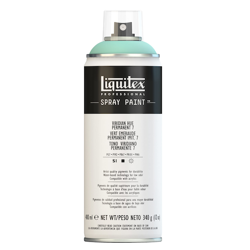
This is a high-quality water/alcohol-based formula for fine artists with a matte finish.
Liquitex comes in traditional artist colors and is compatible with the brand’s other acrylic paints and mediums. It’s low-odor and less toxic than most solvent-based spray paints. This is my top pick for artists.
This looks very similar to the Ironlak Sugar, in that it is water and ethanol-based (ethanol is drinking alcohol). For this reason, they describe it as “solvent light”, since ethanol is a solvent. This is certainly much safer than spray paints made with petroleum solvents.
The solvents listed on the SDS include ethyl alcohol aka ethanol 18-27%, dimethyl ether, the propellant (10-30%), and acetone (0.1-3.5), with a few other solvents at less than 1%.
Uses: Murals, stenciling, underpainting, painting sculpture, collage & mixed media.
Substrates: Stretched canvas, cardboard, glass, wood, masonry, brick, ceramics, and styrofoam.
Where to use: Can be used indoors for art studio use and outdoors. Once dry it is permanent and water-resistant.
Clean up: Soap and water.
Colors: 100 artist colors including gold, silver, and some fluorescents.
Reviews: Reviews state that the odor is very mild.
There is a Prop 65 warning on the Walmart listing, the company has not said what chemicals that warning is for.
Where to buy (US): Walmart, Blick’s, and Amazon
- Where to buy Canada: Amazon.ca
- Where to buy Australia: Eckersley’s
- Where to buy UK: UK Art Supply Stores
3. Montana Colors Water-Based Spray Paint

This is a professional quality polyurethane paint for murals and crafts. It’s water-soluble, odorless (they say), and leaves a matte finish.
Montana Colors is a polyurethane-based paint as opposed to the usual acrylic-based options. It’s also a water-alcohol-based hybrid. You will have a polyurethane paint smell and alcohol odor (which offgasses quickly).
The propellant is dimethyl ether DME, it also contains 10-25% ethanol.
The VOCs are listed as 525-460 g/l depending on the color.
Uses: Fine arts, graffiti art, DIY projects, crafts, stencil art, industrial, home decor.
Substrates: Metals including iron and steel, many plastics, glass, wood, terracotta, directly on expanded polystyrene. On plastic, a primer may be necessary.
Where to use: Indoors and outdoors. It has good resistance to outdoor conditions once dry (water-resistant, not waterproof).
Clean up: With soap and water.
Colors: 96 colors including bright colors, muted colors, neutrals, fluorescent colors, gold, and silver.
Reviews: Similar reviews to the other water-based spray paints. Artists and crafters do like it. It has the usual drawbacks of any water-based spray paint. The tiny cans are great for small crafts but it’s also good quality for use on wall murals. Some complaints about the black and white colors for murals.
This would contain a Prop 65 warning in the US for titanium dioxide.
Where to buy (US): Amazon and Blick’s
- Where to buy UK: The Montana Shop UK
- Where to buy Australia: The Montana Shop AU
- Where to buy New Zealand: All City NZ
4. Evolve Agua Water-Based Spray Paint

New on the market, this water-based spray paint is marketed as odorless & eco-friendly. It’s intended for both indoor & outdoor use and comes in vibrant colors with a flat finish.
Evolve Agua is certainly the most affordable option on this list at $8 a can including shipping.
Uses: Graffiti and street art, DIY and craft projects, indoor projects, studio work, murals, canvas work, sculptures, kid and school projects, and outdoor projects.
Where to use: Indoor and outdoor.
Clean up: Soap and water.
Colors: 30 bright colors plus white (no black).
Reviews: Some good reviews including people saying it’s low odor. Like with all water-based spray paints there are complaints about the spray capacity.
Where to buy (US): Amazon
5. Simply Spray Upholstery Fabric Paint

This is a permanent fabric spray paint/dye that is non-toxic and non-flammable and is safe for use by children and adults. It’s the only one on the list with a safer propellant.
Designer Accents Fabric Paint Spray Dye by Simply Spray is the new version of Simply Spray Upholstery Spray Paint.
The spray dye is applied like a spray paint. It soaks into the fabric and leaves it with the original texture.
They say the propellant is the same one used with food products like canned cheese – so nitrogen, or carbon dioxide, I would presume.
You may find the paint has a faint paint odor if you are using a large quantity indoors. If you have sensitivities, you should use the product in a ventilated area to be on the safe side, they say.
Uses: Furniture: couches, recliners, loveseats, indoor and outdoor cushions, chairs, office furniture; Textiles: carpets, pillows, clothes, linens; Outdoors on cushions, hammocks, upholstered furniture, umbrellas, patio furniture, and automotive cloth interiors.
Substrates: Works on natural absorbent textiles. It does not work on vinyl, plastic, or polyester. The fabric must be able to absorb water.
Where to use: Indoors and outdoors.
Clean up: Soap and Water.
Colors: 9 colors.
Where to buy (US): Amazon
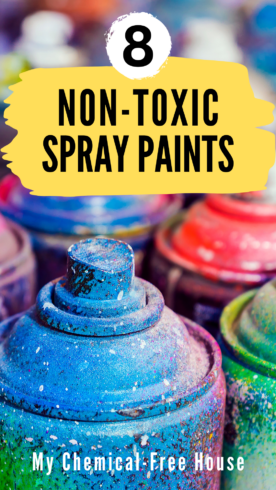
Honorable Mention
More available in Europe:
Molotow Spray Paints are more readily available in Europe than in North America. Their CoversAll is a German-made water-based spray paint. It’s a nitro-alkyd-based paint (nitrocellulose and alkyd resin), except for the pure black which is acrylic. It’s very low odor. The SDS lists MDE as the propellant as well as ethanol (i.e. it’s a water and alcohol hybrid) with the VOCs at <840g/l. Uses: Murals, craft projects, automotive work, and furniture modification. Substrates: Nearly all substrates including wood, metal, concrete, glass, etc.
Molotow One4All line is a high-quality acrylic dispersion. Water makes up approximately 85% of the total paint volume, and the only solvents are those used for the propellant. They describe the paint as opaque, almost odor-free, and highly adhesive.
Discontinued Options:
Krylon no longer makes water-based spray paint like their previous H20 Latex and Eco-Guard lines.
Ironlak Sugar Acrylic Spray Paint (Artist/Mural Paint) – This is a healthier acrylic spray paint that is a hybrid of water and alcohol that’s made from sugar cane. It’s low-VOC and low in odor (it has an alcohol odor but that will flash off very fast). It is a matte look paint. This Spray paint was last produced in 2019. There is still stock left in 2021-2022 at the Australian Store and stores around the world, but that will be the last of this spray paint. Uses: Art, graffiti/wall murals, crafts, stencils, home decor projects.
Lower-Odor Solvent-Based Spray Paint
Solvent-based spray paints are more toxic than water-based options. But if you need to go with a solvent-based spray paint the below brands and guidelines can be useful.
There are two ways to approach solvent-based spray paints if you want to lower your VOC exposure. You can look at the options that have either safer solvents or faster drying solvents, or follow the guidelines below on setting aside the item for the full curing/offgassing time.
Be sure to up your Personal Protective Equipment (PPE) here to the full recommendations and only spray these outside.
I personally would not feel comfortable with children spraying these themselves, but they can be safe for furniture and decor items intended for kids’ rooms once fully cured and offgassed.
1. Loop Colors Graffiti Spray Paint (Less Toxic Solvents)

This 100% acrylic, fast-drying spray paint, is free of aromatic compounds (made with safer solvents). It’s marketed for graffiti, murals, and other spray painting projects for artists.
The solvents contained are free of aromatic compounds like xylene, benzene, and toluene. Benzene and toluene are Prop 65 chemicals.
The primary solvents listed are: hydrocarbons C3-C4 (propane, butane, isobutane), and acetone. It also lists ethyl acetate, n-butyl acetate, and 2-methoxy-1-methylethyl acetate. None of those solvents are Prop 65 chemicals. In this sense, it could be possible to say that this is less toxic than some other options.
Though listing it as low or lower VOC, which I saw in some listings, is rather confusing. The actual VOC levels of 615 g/l is standard (and by no means low). Acetone is actually an exempt VOC because it doesn’t contribute to smog, so it’s not reflected in the total VOC count. (Though acetone does flash off quickly, so that is good).
I even have seen it described as odor-free and non-toxic, I would not go that far personally. But I was not able to personally test this brand so it might be worth trying it to check for speed of offgassing.
If you want a paint that is super durable for exterior murals, and you don’t mind wearing full PPE protection because of the solvents then you could consider this.
Uses: DIY projects, murals, canvas, street art, graffiti, stencils, or any other crafting. Compatible with all surface types and most paint brands.
Colors: 197 colors to choose from – bright colors, muted colors, black, white, transparent colors, and fluorescent colors.
Where to buy (US): Amazon and Blick’s
- Where to buy Canada: The Paint Spot
- Where to Buy UK: Calder Art Supply
2. Rust-Oleum Spray Paints (Low-Odor Options)
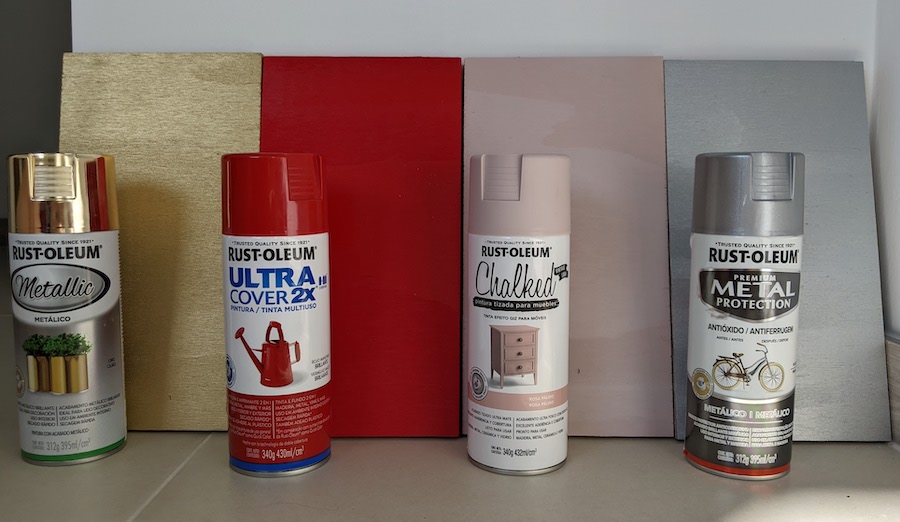
Rust-Oleum does not have any water-based spray paints so I tested out their most popular spray paints to see how quickly they offgassed the VOCs and became odorless.
Rust-Oleum has said that the Universal line which includes Spray matte, Metallic, and Stops Rust Protective Enamel (which is the same as the Premium Metal Protection I tested in Silver) all take 7-10 days to cure. At 10 days I would have no problem bringing in any of these 4 options that I tested, and I feel confident that you would not be able to pick up any VOCs on a professional VOC test at that time. For those who are very sensitive to chemicals, I have some more detailed offgassing times below.
Out of the four I tested, at 12 hours, Metallic in Gold was the strongest, followed by UltraCover in Red, then Premium Metal Protection in Silver, (which is called Stops Rust Protective Enamel in the US), and lastly Chalked in pink had the least amount of solvent odor at that time.
I would not say they are odorless or toxin-free when dry.
What day each of these became odorless to me:
- At 8 days Premium Metal Protection in Silver (which is called Stops Rust Protective Enamel in the US) was very close to odorless. It was the only one that seemed 100% odorless and offgassed at around one month‘s time.
- Metallic in Gold was only slightly behind the Silver at 8 days but it didn’t reach 100% odorless as fast.
- At 14 days Rustoleum Metallic in Gold and UltraCover in Red were virtually odorless to me.
- Chalked in pink was getting close to odorless at 4-5 weeks (to my nose).
I would not use any of these products indoors. If the item is for indoor use I would spray it outside with full PPE leave it outside or in a garage to air out and then bring it inside.
Rust-Oleum Metallic
Rust-Oleum Specialty Metallic Sprays provide a rich, shiny finish for decor and crafts.
It’s a solvent-based acrylic resin paint. The main solvents are acetone, toluene, and n-butane in equal parts (10-25%). The propellant appears to be propane. The Prop 65 warning is for toluene and possibly more. It’s a fast-drying formula.
Uses: picture frames, candle holders, holiday decor, and more.
Substrates: wood, metal, plaster, masonry, or unglazed ceramic. It’s made with real metal leafing flakes.
Where to use: the paint is for items that will only be used indoors.
Colors: Gold, Silver, Brass, Copper.
Rust-Oleum Painter’s Touch 2X Ultra Cover
Painter’s Touch 2x Ultra Cover is a premium general-purpose spray paint. It’s a modified alkyd paint, the main solvents are acetone (up to 50%), naptha, mineral spirits, xylene, n-butyl acetate. The propellant appears to be propane. The VOCs are listed as 553 g/l.
Substrates: Wood, most plastic, metal, wicker, and more. Some plastics made of polyethylene are manufactured in a way that may hinder good paint adhesion.
Where to use: For furniture and items that will be used outside and inside. It has great resistance to water (what most people would mean by the term waterproof). Personally, I would only apply this outside even if the item is intended to be used inside when cured.
Colors/Sheens: From high gloss to ultra-matte, it comes in bright colors, neutrals, and black and white.
There is a Prop 65 for at least ethylbenzene and titanium dioxide.
Rust-Oleum Chalked Ultra Matte Sprays
Rust-Oleum Chalked Ultra Matte is an ultra-matte chalk finish. Chalk Finish paints are also known for having good adhesion to many substrates.
This is an acrylic-modified alkyd paint. Acetone is the primary solvent at up to 50%, followed by mineral spirits and naptha. Propane looks to be the propellant.
Uses: Furniture and home decor. It can be sanded and distressed.
Substrates: It works on most surfaces without priming. For better coverage, a Rust-Oleum primer can be used on bare and treated wood.
Where to use: This is for furniture and items used indoors. Though personally, I would only spray apply this outdoors or in a garage.
Colors: Pastel colors, bright red, charcoal, white.
Stops Rust Protective Enamel (US name), aka Premium Metal Protection (in other parts of the world)
Stops Rust Protective Enamel, which is part of their Universal line, is an oil-modified alkyd. The main solvents are acetone (up to 25%), N-butyl acetate, and aromatic hydrocarbons. The propellant appears to be propane.
Substrates: Ideal for ferrous and non-ferrous metal and wood surfaces.
Where to use: For furniture and items used indoors and outdoors.
Colors/Sheens: Over 50 colors in four finishes (gloss, semi-gloss, satin, and flat). In the Stops Rust line, they do have metallics including rose gold.
There is a Prop 65 for at least ethylbenzene and titanium dioxide.
Where to Buy Rustoleum Spray Paints (US): Amazon, Home Depot, Lowes
- Where to buy Canada: Amazon.ca, Home Depot, Lowes
- Where to buy Australia: Bunnings
3. Krylon
Krylon no longer makes any water-based spray paint, all of their spray paints are solvent-based. The company has made it a priority to reduce the amount of solvent used in its paint formulations, they say. They recommended that I take a look at Krylon Iron Guard as a less toxic option.
Krylon now uses sustainable raw materials such as soy oil in many of its spray paints.
Krylon Iron Guard is an acrylic latex enamel. Dimethyl ether is the propellant, the next solvent listed is ethylene glycol butyl ether at 10%. There are certainly fewer hazardous chemicals listed here compared to other solvent-based spray paint. It definitely could be worth testing.
Uses/Substrates: For metal, most plastics, plastic foams, wood, masonry, plaster.
Colors: 7 bright colors, 9 neutrals including black and white.
Clean up: Soap and water while wet, mineral spirits if not cleaned up right away.
Where to buy (US): Amazon (with a business account)
Non-Toxic Spray Applied Paint (Alternatives to Aerosol Spray Paint)
A less toxic option to all of the paints above is to spray apply water-based non-toxic paint. This eliminates the propellant in the aerosol cans.
You can still get really good performance from these paints, one is made for bare metal as a primer, the others are for over already painted metal and other difficult surfaces like glass, oil-based paint, and enamel finishes.
You can rent a spray gun or hire a professional to spray apply the paint for you. Check the instructions on each paint brand for spray application, but generally, all you have to do is dilute it with some water and choose the recommended spray gun.
These are really my top choices for painting furniture for babies or kids, animal enclosures for sensitive pets, or for chemically sensitive people.
1. Chalk or Chalked Paint

Chalk Paint, brushed on or spray applied, is an obvious replacement for many aerosol spray paints.
It has excellent adhesion to just about every material including most metals, glass, ceramic, oil-based paint, shellac, plastics, wood, drywall, fabric, concrete, brick, and stone.
My review of Annie Sloan Chalk Paint goes over more details.
Chalk Paint is only for interior use.
For added durability, you can add a natural wax or synthetic zero-VOC protective topcoat.
It’s extremely low in odor, even lower in odor than your typical zero-VOC acrylic paint.
Here is a video on how to spray apply it.
Where to buy (US): Chalked Paint from Amazon or Home Depot. Annie Sloan through their website.
2. AFM MetalCoat Primer
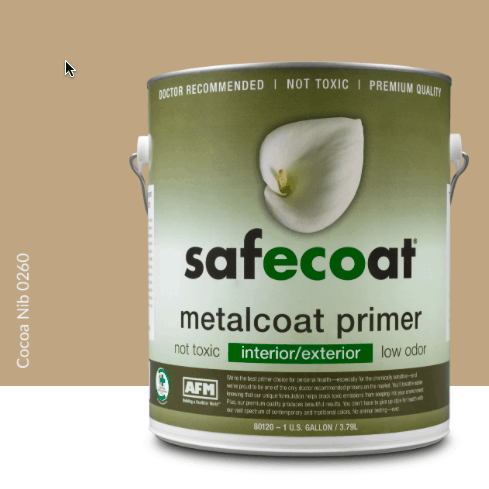
AFM MetalCoat can be applied with an airless sprayer, brush, or roller. This paint is low-VOC (though not as low as Chalk Paint or ECOS below) and can be used on interior and exterior bare metal.
It can be used on galvanized steel, aluminum, and any non-ferrous metal. It sticks to nickel, tin, titanium, iron, zinc, brass, gold, silver, platinum, cobalt, tungsten, bismuth, cadmium, and zirconium.
It’s not recommended for copper or cast iron or any metal that has rust. This primer is not made for functional radiators as it can not take that level of heat.
Chalk Paint above is a good non-toxic paint for radiators (this post goes into more detail on non-toxic brands for painting radiators).
This primer is for bare metal only and can be followed by any of the AFM paints. If you want to paint over metal that already has a paint on it, use AFM Transitional Primer, followed by their paint.
It is safe to use on pet cages, like bird cages, parrot aviaries, dog crates, etc.
They aren’t FDA-approved food-safe, but once it’s fully cured and if it doesn’t go into a dishwasher, it is considered to be safe.
Where to buy (US & Canada): GDC/Building for Health
3. ECOS Universal Primer
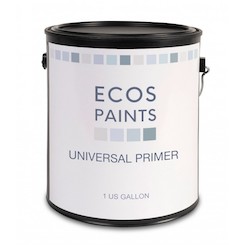
ECOS paint and primers can be brushed or rolled on but not spray-applied.
ECOS Universal Primer that can be used on metals like bare iron and steel (not cast iron). It is for both interior and exterior use.
This is a good option for difficult surfaces like over oil-based paint (with the proper prep), and many metals, both raw and factory-primed (like factory-primed doors and cribs). It can work on some plastics as well, you might need to do a test first.
This primer is water-based and zero-VOC so it’s super safe for people including children, babies, and pets. It can work for metal pet cages, like dog crates, birdcages, and wood cages that are either inside or outside. It’s perfect for furniture for a baby’s room (including cribs), play gyms, and other items for kids.
This is a primer, so be sure to follow with the appropriate interior or exterior paint by ECOS as well.
I like ECOS because all of their paints are zero-VOC and their products are high quality as well.
Where to buy (US & Canada): ECOS website
Food-Safe Spray Paint
Rust-Oleum High Performance V2100 Rust Preventive Enamel Spray Paint meets USDA requirements for incidental food contact.
Krylon said: “We don’t manufacture a product that is FDA-approved. An FDA approval is important in terms of whether a product film is safe for incidental ingestion. We do not perform animal testing and cannot test for ingestion. Therefore, we offer nothing that is guaranteed to be food safe if it is ingested or encounters someone’s mouth. Having said that, many of our customers apply our products on countertops. Just make sure to set or prepare food on a cutting board/trivet/food-safe surface.”
AFM Safecoat Metal Primer + Exterior paint or ECOS Paints might be considered defacto food-safe based on the ingredients, though they are not FDA-approved. They can be spray applied but are not spray paints.
Sealants: You might consider sealing the painted surface:
- With a food-safe thin two-part epoxy resin, the same ones used to seal wooden bowls and tables which will come in contact with food. (Epoxy does contain BPA)
- With a food-safe acrylic sealer.
- Zinsser Shellac products are not FDA-approved for food contact. Though putting a shellac (pure food grade shellac flakes mixed with food-grade ethanol) does help to act as a protectant, limiting leaching from the paint and providing a food-safe top coat.
Biodegradable Spray Paint
The only types of spray paint that can come in a biodegradable formula are marking paint spray paints. They are used to mark lines on the ground.
Marking Paint can be used in construction areas, landscape design, excavation sites, traffic safety, DOT sites, athletic sites, survey crews, utility lines, buried cables, and much more. They may be used on asphalt, concrete, gravel, dirt, and grass.
It washes away in 2-8 weeks and some brands like this Rainbow Marking Paint are biodegradable.

Corinne Segura holds certificates in Building Biology, Healthier Materials and Sustainable Buildings, and more. She has 10 years of experience helping others create healthy homes.

Hulda
I’m looking for a non-toxic, abrasion resistant copper spray for gardening tools.
Do you know of a paint/spray paint fits the bill?
Thanks
Hulda
Giorgio
Unless you’re looking to create an item for display, you should go with stainless steel.
Or, if you have a favorite tool, find a metal working shop and have a copper coating anodized onto the metal.
Another option isto have paint added by electrostatic application, which many auto paint shops can do.
RA
Hi Corinne,
I am trying to see if a plastic sheeting Made of polyethylene for vapor barrier would be safe to use? https://www.homedepot.com/p/HDX-20-ft-x-100-ft-Clear-6-mil-Plastic-Sheeting-CFHD0620C/204711640
Unable to find anything on this topic of vapor barriers or plastic sheeting.
Thank you
Ra
Any response on this would be helpful?
John
Hello
I wanted to paint vinyl shades
What would be the safest
Method and paint to use for a dark grey color?
Mariane
Hi Corinne,
Your website has been such an amazing resource for our family. Thank you.
I was wondering if you know how toxic would it be if a neighbor uses spray paint out on their backyard by our fence and we had al windows open and we smelled solvent inside and around baby. I am sensitive but I would say it took about 15 minutes for smell to be gone. I moved baby away from the smell and outside within 5/10 minutes but I freaked out about the smell. The neighbor I believe was 12 feet from our nearest window, and we were more than 20 feet from the source but we smelled it. Thanks so much.
Gillian
Thanks for sharing! I am researching how to do low environmental impact/eco friendly spray painting & graffiti art- this is the best resource I have found so far! Thank you ☺️
Katie
Thank you so much for this this is SO helpful!!!!!